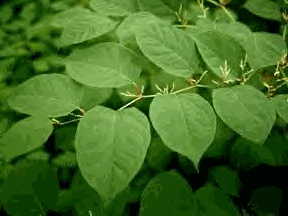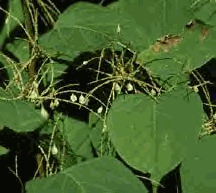Japanese Knotweed

INTRODUCTION: Japanese knotweed, a member of the buckwheat family (Polygonaceae), is an upright, shrublike, herbaceous perennial that can grow to over 10 feet in height. Although leaf size may vary, they are normally about 6 inches long by 3 to 4 inches wide, broadly oval to somewhat triangular and pointed at the tip. The minute greenish-white flowers occur in attractive, branched sprays in summer and are followed soon after by small winged fruits. Seeds are triangular, shiny, and very small, about 1/10 inch long.
ECOLOGICAL THREAT: Japanese knotweed spreads quickly to form dense thickets that exclude native vegetation and greatly alters natural ecosystems. It poses a significant threat to riparian areas, where it can survive severe floods and is able to rapidly colonize scoured shores and islands. Once established, populations are extremely persistent.
HABITAT IN THE UNITED STATES: Japanese knotweed can tolerate a variety of adverse conditions including full shade, high temperatures, high salinity, and drought. It is found near water sources, such as along streams and rivers, in low-lying areas, waste places, utility rights-of-way, and around old homesites. It can quickly become an invasive pest in natural areas after escaping from cultivated gardens.
 BACKGROUND: Japanese knotweed was probably introduced to the U.S. in the late 1800's. Also known as crimson beauty, Mexican bamboo, Japanese fleece flower, or Reynoutria, it was first introduced as an ornamental and has also been used for erosion control and for landscape screening. It is now found throughout the eastern U.S., in several western states, and Alaska, which has few exotic invasive plants to date.
BACKGROUND: Japanese knotweed was probably introduced to the U.S. in the late 1800's. Also known as crimson beauty, Mexican bamboo, Japanese fleece flower, or Reynoutria, it was first introduced as an ornamental and has also been used for erosion control and for landscape screening. It is now found throughout the eastern U.S., in several western states, and Alaska, which has few exotic invasive plants to date.
CURRENT MANAGEMENT APPROACHES: Grubbing is effective for small initial populations or environmentally sensitive areas where herbicides cannot be used. Using a pulaski or similar digging tool, remove the entire plant including all roots and runners. Juvenile plants can be hand pulled depending on soil conditions and root development. Any portions of the root system not removed will potentially resprout. All plant parts (including mature fruit) should be bagged and disposed of in a trash dumpster to prevent reestablishment.
Cut stem treatment: Use this method in areas where plants are established within or around non-target plants or where vines have grown into the canopy. This treatment remains effective at low temperatures as long as the ground is not frozen. Cut the stem about 2 inches above ground level. Immediately apply a 25% solution of glyphosate (e.g., Roundup, or use Rodeo if applying in or near wetland areas) or triclopyr (e.g., Garlon) and water to the cross-section of the stem. A subsequent foliar application of glyphosate may be require to control new seedlings and resprouts.
Foliar spray method: Use this method to control large populations. It may be necessary to precede foliar applications with stump treatments to reduce the risk of damaging non-target species. Apply a 2% solution of glyphosate or triclopyr and water to thoroughly wet all foliage. Do not apply so heavily that herbicide will drip off leaves. A 0.5% non-ionic surfactant is recommended in order to penetrate the leaf cuticle, and ambient air temperature should be above 65 ºF.
Adapted from a piece by Tom Remaley, Great Smoky Mountains National Park, Gatlinburg, TN.
Pictures by Tom Remaley, Great Smoky Mountains National Park, Gatlinburg, TN and Jil M. Swearingen, U.S. National Park Service, Washington, DC.

